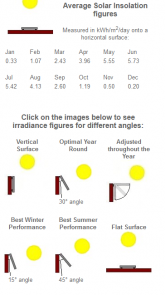Hello!
I'm in the process of upgrading our offgrid small holiday cottage solar power system and I would like some input on a new battery system and perhaps some other considerations as well.
Old setup:
We're keeping the panels, charge controller and inverter, but changing to 24VDC for improved efficiency. Our main problem is that we often have to take sudden heavy drain from the batteries in the form of a dishwasher or a power tool. This sometimes crashes the 240 AC system and is a torment on battery health. This is why we are considering a battery system better prepared for sudden deep depletion cycle, such as a 2V forklift lead acid battery in a series of 12. We originally considered 6V Rolls solar batteries in a series of 4 units, but our main usage problem is not long term steady power consumption, but sudden deep drain.
As for the batteries we have a reasonable offer for new 2V american made forklift batteries:
-12 units 2V 420Ah 3EPzS = 1825€
-12 units 2V 560Ah 4EPzS = 2210€
-12 units 2V 620Ah 4EPzS = 2396€
What do you guys think of 24V system made with a series of 12 2V forklift batteries with our solar setup? I'd personally go for the 620Ah, but is it oversized for our charging capacity?
Ps. We also just purchased a small wind mill generator for general upkeep with 800W advertised, but I expect to get 20-50W. How should I connect this with the solar charge controller?
I'm in the process of upgrading our offgrid small holiday cottage solar power system and I would like some input on a new battery system and perhaps some other considerations as well.
Old setup:
- 1kW solar panels
- Outback Power Flexmax 60 (FM60-150VDC) charge controller
- Outback Power 2,6kW inverter (Not sure which model, probably sealed FX2524T)
- 3 units of 12V 210Ah AGM batteries (Cheap crap) in parallel (630Ah)
- 12VDC and 240AC power systems
We're keeping the panels, charge controller and inverter, but changing to 24VDC for improved efficiency. Our main problem is that we often have to take sudden heavy drain from the batteries in the form of a dishwasher or a power tool. This sometimes crashes the 240 AC system and is a torment on battery health. This is why we are considering a battery system better prepared for sudden deep depletion cycle, such as a 2V forklift lead acid battery in a series of 12. We originally considered 6V Rolls solar batteries in a series of 4 units, but our main usage problem is not long term steady power consumption, but sudden deep drain.
As for the batteries we have a reasonable offer for new 2V american made forklift batteries:
-12 units 2V 420Ah 3EPzS = 1825€
-12 units 2V 560Ah 4EPzS = 2210€
-12 units 2V 620Ah 4EPzS = 2396€
What do you guys think of 24V system made with a series of 12 2V forklift batteries with our solar setup? I'd personally go for the 620Ah, but is it oversized for our charging capacity?
Ps. We also just purchased a small wind mill generator for general upkeep with 800W advertised, but I expect to get 20-50W. How should I connect this with the solar charge controller?



